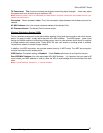
Billion 800VGT Router
Wireless
Parameters
WLAN
Service:
Default
setting
is
Enable
.
If
you
do
not
have
any
wireless
devises
(802.11g
or
802.11b)
on
your
network,
select
Disable.
Mode:
The
default
setting
is
802.11b+g
(Mixed
mode).
If
you
do
not
know
what
type
of
wireless
devises
you
have,
or
have
both
11g
and
11b
devices
on
your
network,
then
keep
the
default
setting
(
mixed
mode)
.
From
the
drop-down
menu,
you
can
select
802.11g
if
you
have
only
11g
clients
on
your
network
or
if
you
have
only
11b
clients
on
your
network,
then
select
802.11b
.
ESSID:
The
ESSID
is
the
unique
name
of
a
wireless
access
point
(AP)
used
to
distinguish
it
from
other
AP’s.
For
security
purposes,
change
the
default
AP
ID
(
wlan-ap)
to
a
unique
ID
name.
The
ESSID
is
case
sensitive
and
must
not
excess
32
characters.
Make
sure
your
wireless
clients
have
exactly
the
same
ESSID
as
the
AP
so
that
you
will
be
able
to
connect
to
it
.
ESSID
Broadcast:
ESSID
Broadcast
is
the
function
that
controls
the
Routes
transmission
of
its
ESSID.
This
transmission
enables
wireless
clients
to
detect
the
presence
of
the
AP
when
they
search
for
AP;s
to
connect
to.
The
default
setting
is
Enabled.
Disable:
I
f
you
do
not
want
broadcast
your
ESSID.
Any
client
using
“any”
wireless
setting
cannot
discover
the
Access
Point
(AP)
of
your
router.
Enable:
Any
client
using
the
“any”
setting
can
discover
the
Access
Point
(AP).
Regulation
Domain:
There
are
seven
Regulation
Domains
for
you
to
choose
from,
including
North
America
(N.America),
Europe,
France,
etc.
The
Channel
ID
will
be
different
based
on
this
setting.
Channel
ID:
Select
the
wireless
connection
ID
channel
that
you
would
like
to
use.
Use
the
Scan
Channel
Usage
to
help
to
select
non-occupied
wireless
channel.
Scan
Channel
Usage:
Wireless
channel
scan
takes
up
to
14
seconds
to
survey
the
wireless channels
i
n
the
surrounding
area. The
result
will
show
which
of
the
wireless
channels
are
already being
used
, and
which
are
available
for
use.
Note:
Wireless
performance
will
be
degraded
if
you
select
a
channel
that
is
already
being
occupied
by
other
AP(s).
32
Chapter
4:
Configuration


















